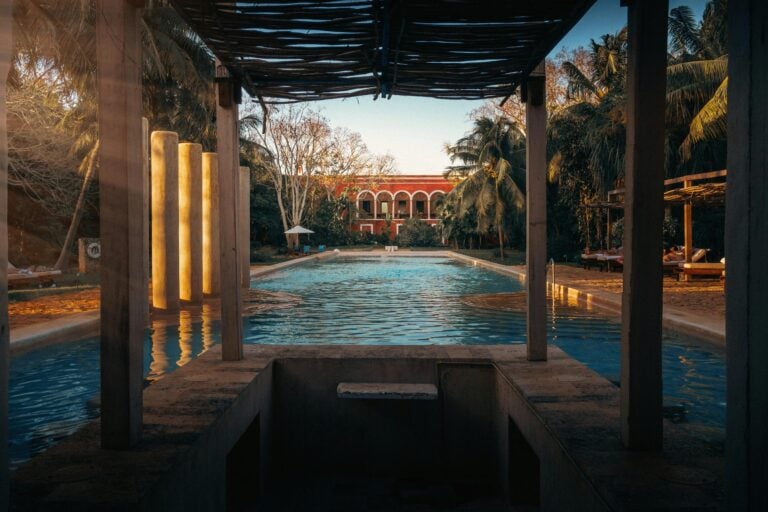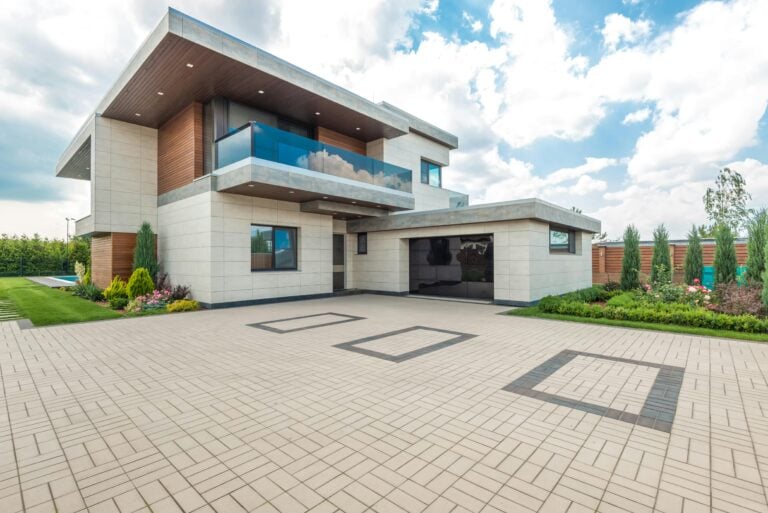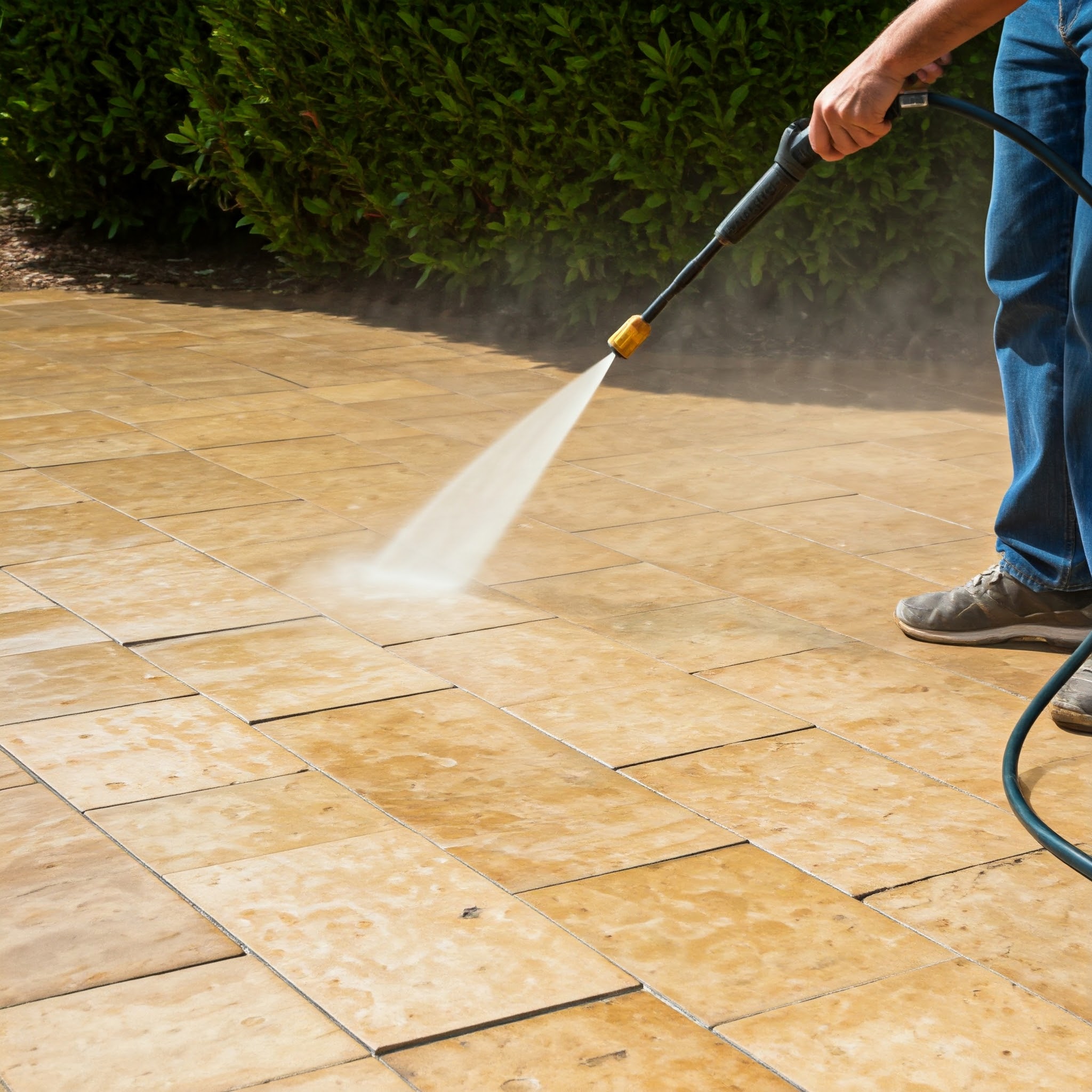Natural stone is the best option of material when it comes to pavers around your pool area. However, when you are designing your pool surrounds, choosing the right pavers is crucial for both aesthetic and functional purposes. That is why we highly recommend opting for either granite pavers or travertine pavers.
These two stones are perfect for use as pool pavers. But which one is right for you? In this guide, we will break down the main differences and compare both granite and travertine.
Before we get started, it is important to understand the main considerations for choosing your pool stone pavers.
The colour and texture of your chosen pavers should complement the outdoor style and space of your home. Consider what works with your architectural style and your outdoor area, and think about the visual impact you are trying to create.
While natural stone materials of all kinds are highly durable, pool pavers are exposed to a variety of chemicals, such as chlorine and salt, foot traffic and weather conditions. That’s why you need stone pavers with high resistance to wear and tear.
Safety is paramount in and around pools. That is why it is recommended that you opt for a non-slip surface to prevent accidents as the pavers are likely to be wet a significant amount of the time.
Pool pavers are often in direct sunlight, especially here in Sydney, Australia. Make sure you choose a material, such as stone, that remains cool underfoot even during the hot summer months.
All pool pavers require some degree of maintenance. However, some require more time, effort and money to keep looking and functioning optimally. Consider your appetite and willingness for ongoing maintenance.
Cost is always going to be an important factor. While this refers to the cost of the stone material and labour required for installation, it should also factor in ongoing maintenance costs and the return on investment of a long-term, long lasting solution as opposed to one that won’t stand the rest of time.

Granite pavers are a popular option for use around pools. When it comes to durability, granite is up there with the hardiest of stones. However, it is not entirely resistant to chipping and cracking – which is a consideration for households with pools subject to lively activity.
As far as aesthetic appeal goes, granite offers an elegant and refined look. It can be finished in a variety of ways and comes in a wide range of colours, shades, and style so matching it to your existing or intended design is easy.
On a practical note, granite pool pavers are generally quite slip resistant. Of course, when wet, it can be more slippery but there are numerous anti-slip solutions that can be applied and ensure you enjoy all the benefits of granite without the loss in safety.
Granite pavers require low maintenance and are highly resistant to stains. Simple cleaning and resealing every so often is more than sufficient to ensure your pool pavers look and function optimally for long into the future.
Granite stone is not the cheapest material for use around your pool. However, the long lasting and durable nature of the material means that the initial investment will long outlast other types of pool paver materials.
Travertine pavers are also a good and popular option for pool surrounds. It is a highly durable material as well, though – amongst natural stone varieties – it is more porous than other options. However, with regular, professional resealing travertine pavers can be easily maintained.
Travertine brings with it a highly unique aesthetic. Its earthy tones and unique texture makes it perfect for natural landscapes and rustic design styles. Like granite and other stones, travertine is available in a rather surprisingly wide variety of different colours and patterns. So, finding the right aesthetic for you is easy.
Travertine is naturally far more slip-resistant than granite and other pool paver options. This is due to its inherent texture, providing more friction and grip than smoother stone varieties. Additionally, it is quite heat resistant so it will feel comfortable underfoot even under the harshest of sunlight.
From a cost perspective, travertine is the more affordable option, compared to granite. However, it is important to consider not just the initial cost but the ongoing cost of maintenance. Being more porous, especially around pool water, travertine pavers may require more regular sealing.
In summary, both granite pavers and travertine pavers come with advantages and disadvantages.
Choosing between granite and travertine pavers for your pool surround will come down to your preferences, priorities and price sensitivity.
Both granite and travertine pool pavers are fantastic options to transform your pool area and turn it into something unique, beautiful and functional.
If you would like to discuss your pool paver needs in more detail or want to arrange a time to come into our showroom and view these stone varieties for yourself in person, make sure to give the Euro Marble team a call today.
Limestone pavers are an excellent option for your pool and outdoor area. The inherent beauty, structural integrity, and non-slip surface make limestone pavers a popular and much loved option.
But if you have limestone pavers around your pool, or anywhere else for that matter, knowing how to clean the stone surfaces in a way that maintains its beauty and integrity is critical.
Cleaning limestone pavers requires careful attention to maintain their beauty and integrity. Here are our top tips, including essential do’s and don’ts for effectively cleaning your limestone surfaces.
Limestone is a sedimentary rock primarily composed of calcium carbonate. It is a highly popular stone for use in interior design, construction, and outdoor settings – such as pool pavers.
Limestone forms through various natural processes. The most common of these is the accumulation of organic materials, such as shells and coral, in marine environments. Over time and under pressure, these materials undergo compaction and cementation, resulting in the solid formation referred to as limestone today.
Limestone appears in various colours, such as white, beige, grey and even blue. The colouring, shading and patterns is influenced by the the level of ‘impurities’ in the stone, such as clay or iron oxide. But the most unique aspect of its aesthetic is caused by the fine-grained texture of the stone. While limestone ranges in smooth to rough textures, the grainy nature adds to its depth of aesthetic appeal.
Limestone is a durable material but is relatively soft compared to other rocks. This is good for cutting and shaping the limestone pavers into shapes for applications around your pool, but the porosity and softness does mean that you should take extra care in your ongoing maintenance of your limestone pavers so it looks and functions as wonderfully as possible.

Over time, limestone pavers can be subject to grime buildup. This is often caused by dirt, leaves and debris leaving stains and discolourations. By regularly sweeping your limestone pavers, you can remove this debris and ensure that the grime and staining does not have a chance to ‘take root’.
When it comes to cleaning natural stone, especially limestone, not all cleaning agents are made equal. Always opt for a pH-neutral (non-acidic) cleaner. Many cleaning detergents are specifically designed for different types of stone. If you are able to source one that is designed for limestone that is ideal.
Once you have your safe cleaning detergent, it is recommended that you mix it with warm, clean water before applying. This helps to both dilute the agent. Always use a soft and clean mop when cleaning the surface and do so gently.
The best way to stop your limestone from staining is to prevent it from getting stained! But spills do occur. When it happens, the quicker you can clean up the spill the better. Liquid spills left unattended have a greater chance of causing stains.
As with all natural stone, limestone pavers should be cleaned through ‘blotting’. This means, instead of wiping up a spill and thereby spreading the liquid around, you blot or dab the spill with a soft and clean cloth to prevent the spread and potential damage.
If your limestone pool pavers do get stained, you can use a soft brush or sponge and apply some gentle scrubbing. Avoid using a hard-bristled brush as these can scratch the surface quite easily.
Once you have applied the cleaning solution, always rinse the pavers off thoroughly with clean water. This removes any residue and minimises the likelihood of longer term damage or stain.
Dry mops or lint-free cloths are good ways to dry polished limestone surfaces. It can easily prevent watermarks from appearing or streaks. Even limestone pavers around pools should be dried where possible, especially if they are not exposed to direct sunlight.
Like most natural stone types, limestone benefits from regular professional sealing. Consider applying a penetrating sealer yourself regularly, but always engage a professional once every few years at least. This will protect your limestone pavers from stains and moisture damage.
Do not use any acidic cleaning agents. Whether vinegar, lemon juice or acidic chemicals, these substances can etch, damage and discolour the limestone pavers’ surface.
Along with acidic cleaners, stay away from bleach or other ammonia-based cleaners. These harsh chemicals will damage your limestone pavers and discolour the aesthetic.
Abrasive scrubbers, such as steel wool, can cause scratches and marks on the surface of the limestone. Only ever use soft bristled brushes or soft clothes and sponges when cleaning this natural stone.
While pressure washing can be used effectively on limestone, it is not recommended. High pressure can force the water into the very pores of the limestone and lead to erosion or damage over time. If you are going to use a pressure hose, make sure it is on the lowest setting.
Limestone pool pavers will naturally dry but if you use any cleaning solutions, do not leave them to dry on their own. It could leave unsightly smudges and/or streaks that will be far more difficult to remove later.
By following these do’s and don’ts, you can keep your limestone pavers looking as pristine as possible for as long as possible. Regular maintenance and careful cleaning not only preserves the stone’s beauty but also enhances its overall functionality for your outdoor spaces.
To speak to the experts of all things limestone pavers Sydney-wide, give the Euro Marble team a call today.

